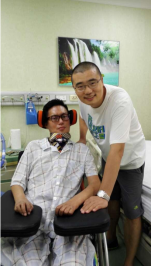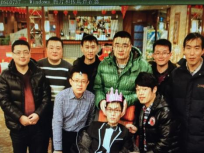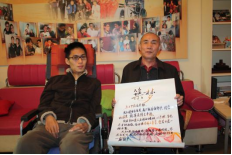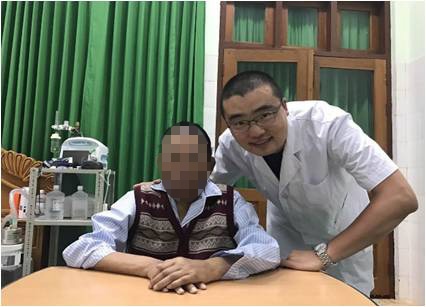
Mr. Wang Jia, a 27-year-old individual, had his life irrevocably altered when, in 2008, he was diagnosed with Amyotrophic Lateral Sclerosis (ALS). This neurodegenerative disorder, also known as Lou Gehrig's disease, is characterized by the progressive degeneration of motor neurons in the brain and spinal cord, leading to a gradual loss of muscle control.
Since the diagnosis, the disease has been relentlessly advancing. By the time 2010 rolled around, his condition had deteriorated to the late - stage of ALS. Facing a critical juncture in his battle against this debilitating illness, he opted for a potentially life-changing treatment approach: stem cell treatment. This procedure, with its promise of replenishing damaged cells and potentially halting the progression of ALS, became his new hope in the arduous journey towards recovery or at least the stabilization of his condition.
• Speech Impairment
The words he utters are often jumbled and unclear, as if they are being formed through a thick, impenetrable fog. This slurring is a direct consequence of the damage ALS has inflicted on the motor neurons controlling the muscles involved in speech production. As a result, communicating his thoughts, feelings, and needs has become an arduous task, leading to frustration and a sense of isolation.
• Swallowing Difficulties
His swallow ability has been significantly compromised. Even the simplest act of swallowing has become a complex and perilous process. The muscles responsible for the coordinated movement of food from the mouth to the esophagus have been weakened by the progression of ALS. This not only makes eating a laborious and time-consuming activity but also poses a serious risk of choking, which can lead to life-threatening situations such as aspiration pneumonia.
• High Muscle Tension in Limbs
The muscle tension in his limbs has reached a high level. His arms and legs feel constantly rigid, as if they are bound by invisible ropes. It not only causes discomfort and pain but also severely restricts his range of motion, making it nearly impossible for him to perform even the most basic of physical tasks independently.
• Limb Weakness and Paralysis
His once-strong muscles have been reduced to a state of near-complete inactivity. Only the index finger of his right hand remains functional, allowing him a minimal degree of movement. This finger has become his lifeline for basic interactions, such as pressing a button or touching an object. However, the rest of his body is virtually immobilized, confining him to a sedentary lifestyle and making him reliant on others for daily care.
• Muscle Atrophy
The muscles have visibly shrunk in size, losing their once-firm and robust appearance. This muscle wasting is a result of the lack of nerve stimulation caused by the damaged motor neurons. As the muscles continue to atrophy, his physical strength and endurance decline further, exacerbating his overall debility and making it increasingly difficult for him to carry out any form of physical activity.
First Course of Stem Cell Treatment (Dec 2010)

Outcomes After the First Course of Treatment
• Remarkable Speech Improvement
Mr. Wang Jia's speech has shown a dramatic enhancement. The once-slurred and barely intelligible words have now become much clearer. His pronunciation has improved significantly, allowing him to communicate his thoughts and feelings more effectively. This new-found clarity in speech not only enables him to have more meaningful conversations with his family and friends but also boosts his confidence, as he can now express himself without the constant struggle of being understood.
• Enhanced Swallowing Function
His swallow ability has improved remarkably. In the past, eating was a laborious and time- consuming process due to his poor swallowing function. However, now, the period of his taking meal has become notably shorter. The muscles involved in swallowing have regained some of their strength and coordination, making it easier for him to consume food and liquids. This not only reduces the risk of choking but also allows him to enjoy a more normal eating experience, which is essential for his overall well-being.
• Alleviated Body Weakness
The weakness that once plagued his body has been significantly alleviated. Before, even the slightest physical effort would leave him exhausted. But now, he has more energy and endurance. He can perform simple tasks such as sitting up for longer periods without getting fatigued. This improvement in body weakness is a clear indication that his condition is on the mend, and it gives him the ability to engage more actively in his daily life.
• Reduced Muscle Tension
The high muscle tension that caused stiffness and discomfort in his limbs has improved remarkably. His muscles are now more relaxed, allowing for a greater range of motion. He can move his arms and legs more freely, which was almost impossible before. This reduction in muscle tension not only eases his physical pain but also enables him to perform more complex movements, such as reaching for objects or adjusting his body position.
• Increased Limb Muscle Strength
The muscle strength of his limbs has increased by 2 grades, which is a substantial achievement. This new - found strength is evident in his improved ability to lift objects and perform basic physical activities. For example, he can now hold a glass of water steadily, something that was unthinkable when his muscles were weak. This increase in muscle strength is a positive sign of his body's recovery and bodes well for his future physical rehabilitation.
• Improved Atrophy Muscle Volume
The volume of his atrophied muscles has shown a remarkable improvement. The once - shrunken muscles in his limbs and hands are gradually regaining their size. This is a clear indication that the muscle tissue is regenerating, which is crucial for his overall physical function. As the muscle volume increases, his physical strength and appearance also improve, giving him a more positive outlook on his recovery journey.


Progress Summary & Future Outlook
Mr. Wang Jia's current improvements are highly promising. With clearer speech, he'll be able to communicate more effectively in both personal and professional settings, potentially reconnecting with old friends and engaging in work-related discussions. His enhanced swallow ability ensures better nutrition intake, which will further boost his overall health.
The alleviated body weakness, reduced muscle tension, increased muscle strength, and improved muscle volume suggest he can gradually regain more physical independence.



